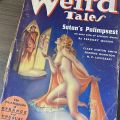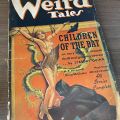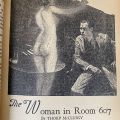During the Spring 2023 semester, Special Collections & Archives collaborated with Dr. Colleen Tripp's English 630, "Modern Monsters: Then & Now." Students in the class selected items from our collections of pulps, comics, and horror stories, then authored a series of blog posts in which they examined visual and other representations of the monstrous in the texts they chose. This is the third post of eight in the series.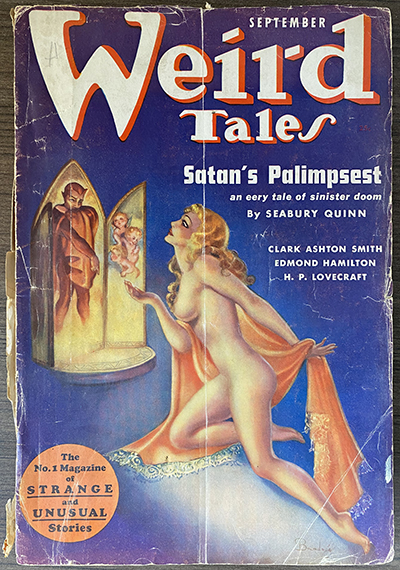
Margaret Brundage’s cover illustration for Weird Tales: Satan’s Palimpsest 1 greets the reader with a nude blonde, seemingly excited to invite the bat-like Satan into her boudoir. Similarly, Margaret Brundage’s Weird Tales: Children of the Bat2 cover greets the reader with another nude blonde—this one half-bat with breasts and chained by another bat, who seems to be half-human as well. Both women on the covers have one thing in common: they either seduce their monster (Satan’s Palimpsest) or fear their monster (Children of the Bat) while looking sexually appealing to the male gaze. Through the covers' portrayal of hyper-sexualized, imprisoned women and bats as their captors, the Weird Tales pulp art combines both the scariness and seduction of the Gothic monster, which represents the Other in U.S. culture.
The cover of Weird Tales: Satan’s Palimpsest opens with the image of a beautiful woman—at least by Eurocentric standards—against the image of Satan, embodying monsters as a foreign Other that we desire. The nude woman is looking into a mirror, and the reflection is a bat-like Satan who overshadows the cherubs on the side. The woman sees herself as a devil in the mirror, and the cherubs represent her guardian angels, warning her to stay chaste, though her deviance is close to taking over. While the woman should fear Satan, she also sexually desires him. The cover art echoes Jeffrey Jerome Cohen’s sixth thesis, Fear of the Monster is Really a Kind of Desire: "[T]he linking of monstrosity with the forbidden makes the monster all the more appealing as a temporary egress from constraint. This simultaneous repulsion and attraction at the core of the monster’s composition accounts greatly for its continued cultural popularity…"3 Satan here represents Cohen’s sixth thesis as a “forbidden” monster, one that appeals to the angelic blonde. The woman is intrigued and attracted to this monster, perhaps representative of this other side of herself. Behind the blond locks and blue eyes, this woman may have a passionate, sexually deviant part of her own identity. Secondly, Satan’s bat-like shape4 recalls bats as “a symbol of androgyne”-- both “the bird of the devil” and also a bird of mystery with no real gender, being a cross between “a bird and a mouse.” In the context of 1930s homophobia, ambiguous gender would have been seen as deviant. Combining an attractive, ingenue-type woman with nudity, sexuality, and a mysterious Other proves how Gothic monstrosity aims to simultaneously scare yet seduce the victim. 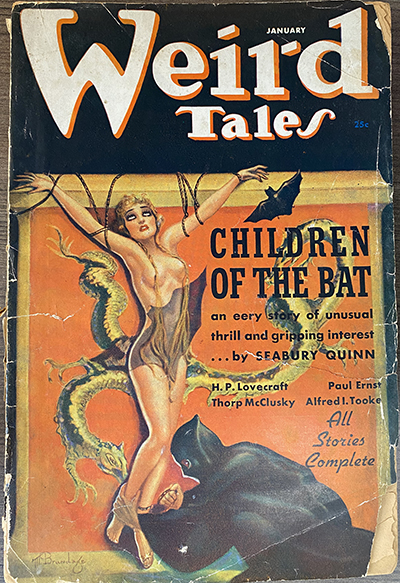
The cover of Weird Tales: Children of the Bat, like Satan’s Palimpsest, also opens with a sexualized blond woman; here, she is being tied up by a bat in an imitation of BDSM. Unlike the Satan’s Palimpsest woman’s seductive expression, though, the woman in the Children of the Bat cover has an expression of fear. The woman seems to be in pain, but is she truly in pain? Or does she enjoy the pain? The woman’s mouth is wide open as if screaming, perhaps out of sexual pleasure. The bat’s appealing masculine physique is almost reminiscent of Batman. The beautiful woman tied up by a handsome, anthropomorphic bat creates an attractive combination to both the Gothic victim and the Gothic reader. The woman’s genitalia, too, is covered with bat wings, symbolizing the sexual union of the woman and the bat. If the bat symbolizes deviance and the pulp is called Children of the Bat, the human craves the Gothic monster because she is part of that monster, bound to him by familial blood. After all, the bat in this picture is literally binding her to his monstrosity.
By including sexualized, passive women and bats on the cover, both Weird Tales texts show us the underlying passion behind monstrosity. One could even take this discussion into the horror genre and ask: why do people like watching horror movies? Is there a deviant part of humanity that, like the woman in Children of the Bat, aches to be tied up and controlled? When one is tied up and controlled, that person can be put—for a temporary amount of time—in the position of the oppressed. They can exit that temporary oppression whenever they want; they can be institutionally vulnerable until it is not fun anymore. Why else would humanity want to experience horror if it was not for the thrill of being scared for a temporary amount of time? One could even argue that from opposites comes sameness; “before there can be unity there must be separation.”5 Hate is often fueled by a secret love; horror, in this case, may be fueled by desire.
1. Quinn, Seabury, et al. Satan’s Palimpsest. Weird Tales, Vol. 30 No. 3, 1937.
2. Quinn, Seabury, et al. Children of the Bat. Weird Tales, Vol 29. No. 1 1936-1937.
3. Cohen, Jeffrey Jerome. “Monster Culture (Seven Theses).” Monster Theory: Reading Culture, edited by Jeffrey Jerome Cohen, NED-New edition, University of Minnesota Press, 1996, pp. 52. JSTOR, https://doi.org/10.5749/j.ctttsq4d.4. Accessed 15 Mar. 2023.
4. Bat. http://websites.umich.edu/~umfandsf/symbolismproject/symbolism.html/B/bat.html. Accessed 27 Apr. 2023.
5. Knott, Robert. The Myth of the Androgyne.
https://www.artforum.com/print/197509/the-myth-of-the-androgyne-36058. Accessed 25
Apr. 2023.



